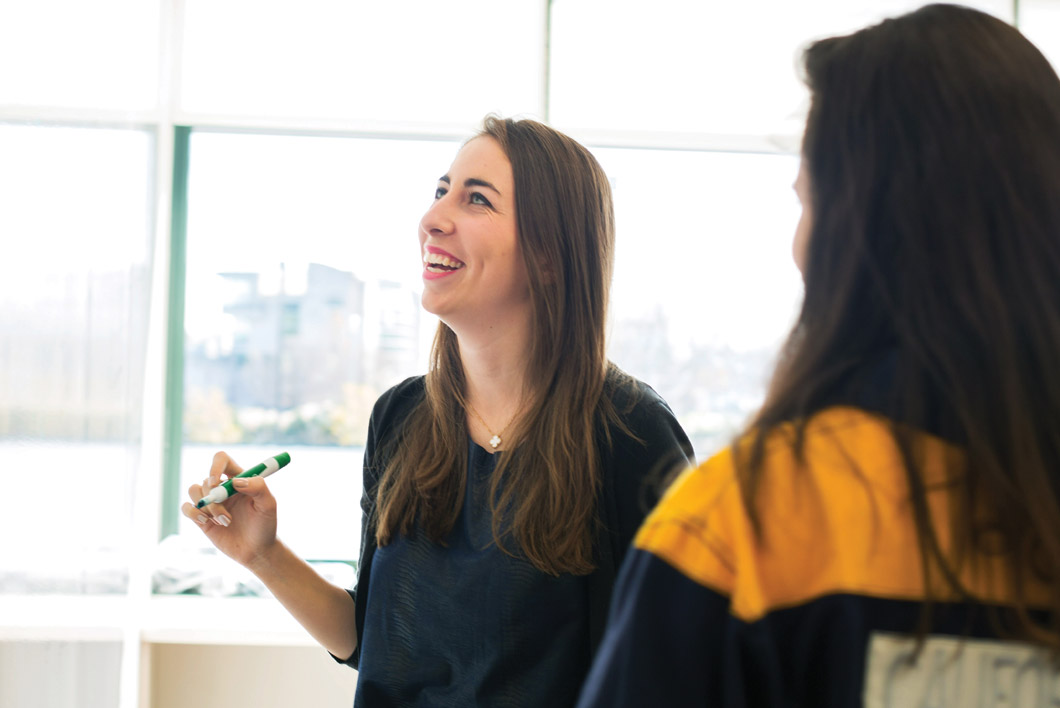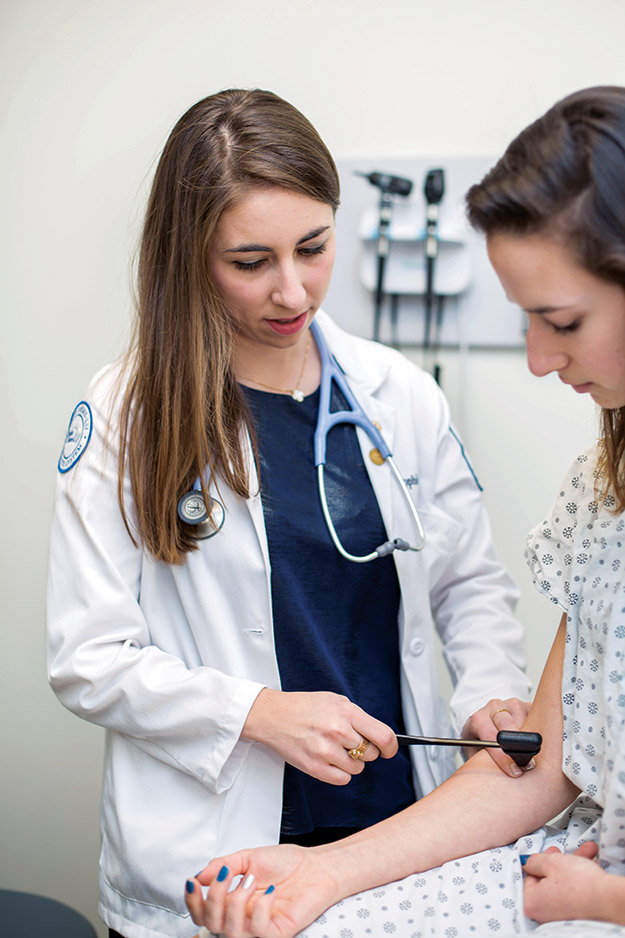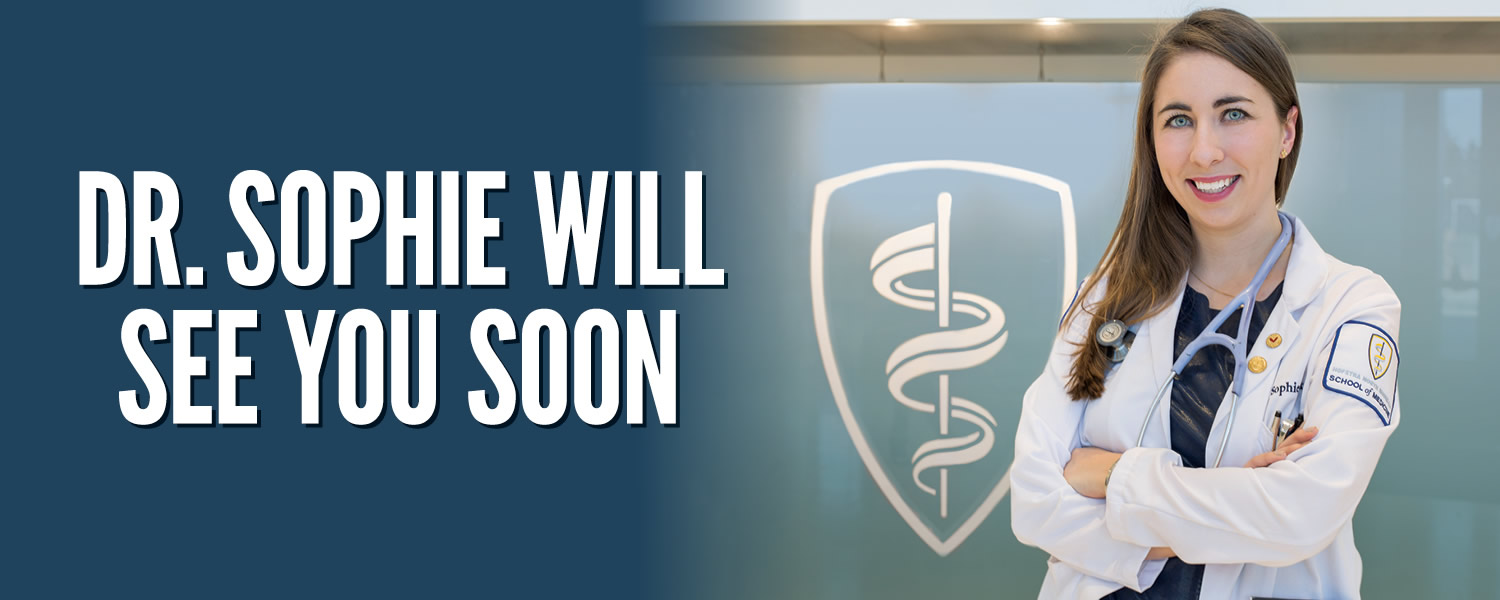Dr. Sophie Will See You Soon
Sophie Parks ’14 pursues a non-traditional medical school education, jelly beans and all.
NOT MANY MEDICAL STUDENTS GET THE OPPORTUNITY TO treat patients before their third year, but for Sophie Parks ’14, patient care began almost immediately, during ambulance runs in Manhattan and Long Island. Parks spent her first 10 weeks at Hofstra North Shore-LIJ School of Medicine becoming a certified emergency medical technician (EMT), where she treated asthma attacks, allergic reactions, head injuries, a cardiac arrest and a heroin overdose. “We were thrown into the deep end immediately, so nothing since then has been as hard to adapt to,” she says.

But the EMT training experience that stands out the most was a day of disaster training with the New York City Fire Department. The situations were very realistic—a simulated subway bombing took place in a real subway car filled with live “victims,” loud noises and smoke. Other simulations included a ferry accident and a bus bombing, and Parks also practiced operating the Jaws of Life, a hydraulic tool used to extricate victims from wreckage. Now in her second year at Hofstra NS-LIJ, Parks is part of a new generation of medical students whose education is self-directed, hands-on and patient-centered.
Going to medical school from Harvey Mudd is not a typical path, but I was really drawn to the College’s goal of educating students on the fundamentals of the sciences. I knew that I wanted that.
– SOPHIE PARKS ’14
From a very young age, Parks was interested in medicine, and she knew she wanted to go to medical school even before she came to Harvey Mudd. Unlike most kids, she loved going to the doctor. “I was always fascinated by doctors. They were people I trusted,” Parks says. Her favorite toys were a plastic medical kit and coat emblazoned with “Dr. Sophie.”
When selecting a college that would help her achieve her goal of becoming a doctor, Parks wanted a place where she could develop a strong foundation in the sciences. “Going to medical school from Harvey Mudd is not a typical path, but I was really drawn to the College’s goal of educating students on the fundamentals of the sciences. I knew that I wanted that,” she explains. After graduating from Harvey Mudd with a degree in biology and chemistry, Parks wanted to be closer to her hometown of Manhattan, so she applied to medical schools in New York, including Hofstra NS-LIJ.
One of the things that attracted Parks to Hofstra NS-LIJ was the students’ enthusiasm for the new curriculum. “The faculty were there because they absolutely believed in how they were teaching. It reminded me of Harvey Mudd, and I wanted a similar learning environment again,” she explains. The Hofstra NS-LIJ MD program, which just graduated its first class in 2015, is vastly different from a traditional medical education.
First, there’s a lot of emphasis on self-directed learning. All material is reinforced in lectures, but a key component of the curriculum takes place in small groups that meet several times a week to discuss different clinical cases. Overall, Parks finds this approach, termed PEARLS—Patient-centered Explorations in Active Reasoning, Learning, and Synthesis— to be a great way to learn. On a typical Monday, the group of eight students is given two cases, each including the patient’s history, symptoms and lab findings. The students then generate a set of learning objectives about each case—things they want to know more about, focusing on the science behind the underlying disease process.

Each student then individually researches all of the learning objectives before the next group session, using whatever resources they want. “We’re not all using the same books, so we end up having really great discussions later in the week,” Parks explains. The rest of the week, the students discuss what they’ve learned in their research and integrate it into big-picture questions that help them understand the material and combine multiple concepts.
One of her favorite aspects of medical school so far has been when she meets patients in the clinic with conditions that have been covered in a PEARLS session. “That’s when I realize how much I’ve learned, and that I can apply what I’ve learned to ask the patient the right questions,” Parks says. And instructors make sure she sees a lot of patients.
In addition to the EMT training, she was also paired with physicians specializing in internal medicine, obstetrics/gynecology and surgery during her first year, where she learned more about each of these specialties hands-on.
One experience in particular, less than two months into medical school, stands out. The first day of her OB/GYN rotation she went to meet with the doctor she would be shadowing so they could get to know each other, but Parks ended up staying for the rest of the afternoon and helping him deliver two babies. “It was so exciting,” she says. “I keep having little experiences like this, that remind me why I’m here.” This year, she is rotating with internists, pediatricians and psychiatrists.
Training in how to interact and empathize with patients is another big part of the Hofstra NS-LIJ curriculum and something the students practice every week. One especially memorable exercise in empathy was a lesson on medication adherence. To teach the students how difficult it is for patients to manage multiple medications, the students were given a sack full of 10 different types of jelly bean “drugs” along with instructions for dosing. They had to develop a schedule and adhere to it for one week. “It was very valuable. Even when they’re jelly beans, it was difficult to follow all of those directions,” Parks says.
Parks isn’t sure what field she would like to specialize in yet. “I’m more drawn to fields that are procedural, like surgery, because they tend to be more interdisciplinary. I like working on a team,” she says. But Parks is also interested in fields like neurology that deal with diseases that doctors still don’t know very much about. “I want to be constantly learning,” Parks adds.
